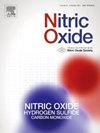Inorganic nitrate stores, astrocyte metabolism and brain health: An emerging paradigm
IF 3.2
2区 生物学
Q2 BIOCHEMISTRY & MOLECULAR BIOLOGY
引用次数: 0
Abstract
Inorganic nitrate plays a crucial role in the regulation of cerebral blood flow and neurotransmission through its conversion to nitric oxide (NO). Astrocytes are star-shaped glial cells and contribute to maintain the blood-brain barrier integrity, regulate neuronal metabolism, support synaptic plasticity and facilitate neurovascular coupling. Inorganic nitrate widely distributed through all organs, with main reservoirs in skeletomuscular and skin tissues. These reserves are easily accessible via bloodstream and processed into nitrite and NO mainly in liver. Processing nitrate/nitrite into NO at organ with main glycogen stores, could suggest an evolutionary coordination between energy metabolism and NO generating pathways. Such spatial arrangement may facilitate the synchronised mobilisation during periods of enhanced metabolic demand, optimising both fuel utilisation and vascular response and assuring optimal fuel distribution. Astrocytes store glycogen in the brain, which support neuronal metabolism during periods of increased neural activity and hypoglycaemia.
This review explores the hypothesis that inorganic nitrate may be stored alongside glycogen in astrocytes and serve as critical reserves for NO production in the brain, particularly during hypoxic conditions. We examine the emerging evidence that astrocytes serve as key mediators in this alternative nitrate-nitrite-NO pathway, potentially influencing cerebrovascular regulation, neuronal energetics, and cognitive function. The integration of findings across molecular, cellular, and systems neuroscience offers new perspectives on how inorganic nitrate intake might support brain metabolism and could inform both preventive strategies and therapeutic interventions for neuro-degenerative disorders such as age-related dementia, stroke or Parkinson's Disease.
无机硝酸盐储存,星形细胞代谢和大脑健康:一个新兴的范例。
无机硝酸盐通过转化为一氧化氮(NO)在脑血流和神经传递中起着至关重要的作用。星形胶质细胞是一种星形胶质细胞,具有维持血脑屏障完整性、调节神经元代谢、支持突触可塑性和促进神经血管耦合等功能。无机硝酸盐广泛分布于人体各器官,主要贮存于骨骼肌和皮肤组织。这些储备很容易通过血液进入,并主要在肝脏中加工成亚硝酸盐和一氧化氮。硝酸盐/亚硝酸盐在主要糖原储存器官中转化为NO,可能表明能量代谢与NO生成途径之间的进化协调。这样的空间安排可以促进代谢需求增强期间的同步动员,优化燃料利用和血管反应,并确保最佳的燃料分配。星形胶质细胞在大脑中储存糖原,在神经活动增加和低血糖期间支持神经元代谢。这篇综述探讨了一种假设,即无机硝酸盐可能与糖原一起储存在星形胶质细胞中,并作为大脑中NO生产的关键储备,特别是在缺氧条件下。我们研究了星形胶质细胞作为硝酸盐-亚硝酸盐-一氧化氮替代通路的关键介质的新证据,可能影响脑血管调节、神经元能量学和认知功能。分子、细胞和系统神经科学的综合发现为无机硝酸盐摄入如何支持脑代谢提供了新的视角,并可以为神经退行性疾病(如年龄相关性痴呆、中风或帕金森病)的预防策略和治疗干预提供信息。
本文章由计算机程序翻译,如有差异,请以英文原文为准。
求助全文
约1分钟内获得全文
求助全文
来源期刊

Nitric oxide : biology and chemistry
生物-生化与分子生物学
CiteScore
7.50
自引率
7.70%
发文量
74
审稿时长
52 days
期刊介绍:
Nitric Oxide includes original research, methodology papers and reviews relating to nitric oxide and other gasotransmitters such as hydrogen sulfide and carbon monoxide. Special emphasis is placed on the biological chemistry, physiology, pharmacology, enzymology and pathological significance of these molecules in human health and disease. The journal also accepts manuscripts relating to plant and microbial studies involving these molecules.
 求助内容:
求助内容: 应助结果提醒方式:
应助结果提醒方式:


